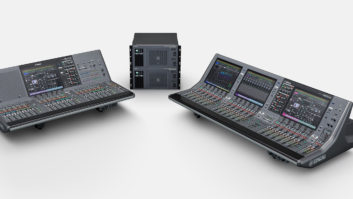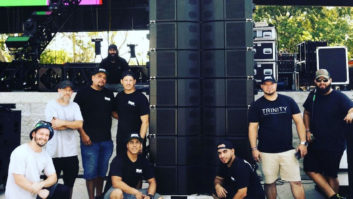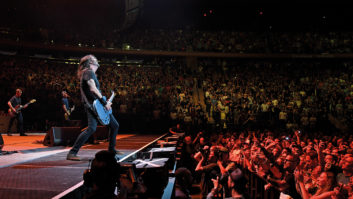After years of hard work and dedication, The National is seemingly universally adored for its brand of unsettling indie rock, but more than a year into supporting 2013’s Trouble Will Find Me album, the group hasn’t slacked off. Case in point: In mid-June, the band played three consecutive, sold-out shows for hometown crowds at the Celebrate Brooklyn Music Festival.
At The National’s monitor mix position, engineer Stu Tenold keeps a tally—seen here taped to the Avid Venue Profile console’s monitor—of how many Beta 58A vocal mics singer Matt Berninger has destroyed on the year-plus-long tour. A few hours before the second concert, held outdoors in Brooklyn’s Prospect Park, FOH engineer Brandon Reid and monitor man Stu Tenold reflected on what it’s like to work for such a hard-working group whose songs can sometimes leave fans pulling out their Joy Division records for a pick-me-up. “The National are great dudes,” said Reid. “They’re unbelievably professional, but also understanding that we live in a real world with challenges.”

The top challenge that day was the local noise ordinance in place for concerts in the park. “This place has an extremely strict dB limitation: 95 A-weighted over a 15-second average, which is pretty tough for a rock gig when we had audience applause hitting 101 yesterday,” said Reid. Ensuring compliance, he said, was achieved by “using Waves’ API 2500 compressor plug-in and an Avalon VT-747SP to compress my mix more than I would usually like to, and also riding the master fader a lot.”
The plug-in was just one of a few Reid had on his Avid Venue Profile (both the FOH and monitor mix positions sported the desk), but he kept the plug-ins to a minimum, preferring to work off the band’s sonic output: “I just use the DigiRack plugins. I use Impact a lot, and I use the 7-band EQ constantly, but I’m more focused on mix moves and master EQ than actually staring at plug-ins. If you’re staring at a plugin and even for a second your lead vocal gets below where it needs to be in the mix, you’ve undermined what you were probably trying to do with that plug-in—so I’m more into having my hands on faders and mixing the show. That being said, this is what works for the National; other things work for other bands. From a mix engineer perspective, the National definitely are going for an organic rock performance and are not looking for heavy-handed audio interference.”
In keeping with that organic philosophy, Reid’s deep familiarity with The National’s catalogue enables him to mix on the fly without snapshots: “I’ve done over 1,000 shows with these guys since 2005; I know their music really well and it’s more comfortable for me to have an organic mix. Also, the National varies the setlist every night, but it has trends where there are usually two or three songs that are always played in conjunction. Even though I don’t have snapshots, I’m memorizing my mix changes, so between songs, it’s almost like muscle memory for me to change settings for the next song.”
When The National played three sold-out shows in its hometown of Brooklyn, NY at Prospect Park Bandshell, FOH engineer Brandon Reid’s mix was heard via a SLS RLA/2 line array bolstered by with d&b audiotechnik JSubs and Q7s. Every song has its own challenges— and making sure singer Matt Berninger’s baritone delivery can be heard in the mix is usually one of them. “Matt’s tough,” said Reid. “His mic control is horrible, his physical output is mediocre. He does his thing and he sounds amazing, but he requires a lot of support. On a scale of one to 10, for the amount of lead vocalist attention he needs, he’s probably a solid eight. Because he sings in a baritone, he doesn’t have a lot of physical output—so because that’s the reality of what we live in, it plays a major role in the gain structure of the front of house mix. He will limit the overall potential of the volume every show. I route Matt’s vocals through a subgroup, there’s a 31-band EQ inserted on it, and the ballad-y songs give me an opportunity to go in and make minor corrections.”

On stage, the band uses around 30 mics, all but six of them Shure microphones, according to Reid. Accordingly, the drums are picked up with a Beta 52A on the kick, Beta 57A on the snare, Beta 56As on the toms, a Neumann KM 184 on the hi-hat and AKG C414s on overheads. An AKG D11 captures the bass cabinet, while a mix of Sennheiser e604s and e609s and Shure KSM 44s and KSM313/NEs take everything the guitar amps dish out. All vocals are entrusted to Shure Beta 58As, because not only do they capture Berninger’s voice faithfully, but they’re also hardy enough to survive getting banged around by the singer.
Over in monitorworld, Tenold used his Profile desk to send mixes to the band via Shure PSM 1000 receivers connected to Ultimate Ears UE 11 and UE 7 earpieces. As backup, two wedges were on hand for what Tenold described as “complete ‘oh crap, everything went wrong— the lead singer lost his pack, lost his ears’ moments.”
Tenold used snapshots for every song in order to keep up with the bands’ dynamic style. “I have snapshots of every song because the way that they play varies so much from song to song, and they’ll change positions on stage,” said Tenold. “Every single member except for the bass player changes position at some point in the set, so it’s something where you can’t just change those mixes on the fly for seven guys.” He also tries to bring each venue’s ambiance into the mix as well. “The stage vibe of having the reverberation of the room—all that stuff ends up coming down the band’s mics. When they hear it, it’s comforting for them. It kind of muddies the mix up in some ways, but it makes it feel like a show for them,” said Tenold. “There’s something about hearing what you’re putting out coming back to you. There is a pair of Shure SM89 shotgun mics that I use to capture the ambiance of the space on the far stage left and stage right, and the guys have different amounts of those in their mix depending on what they want to hear.”
While the engineers prefer to use d&b audiotechnik systems whenever possible, playing three nights in Prospect Park required using the venue’s dual hangs of 12 SLS RLA/2 ribbon line array speakers each—the house system since 2004. Nonetheless, a compromise was achieved: “The venue wouldn’t allow us to bring in our own PA, but we could bring in subs,” said Reid. “We’ve got 12 d&b JSubs out there and all of the front fills are d&b Q7s, so in conjunction with them, the SLS is doing enough to give me the feeling that I’m winning.”
Making the most of the situation was indicative of the engineers’ flexibility, but it also reflected their bond with the band, too. As the line to get into the show started to wrap around the park, Reid explained, “Luckily, both Stu and I have a very trusting relationship with the band, so when we present them with a challenge, they know we’ve done everything we could to make it right.”







